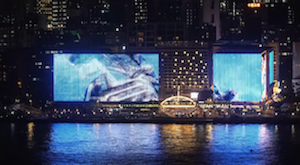Media: video and sound
Format: DCP, Pro Res QT. projection. 3840×1080 pixel. color 25p
Year: 2022
Duration: 23:52 minutes
Languages: Hebrew and English
Subtitles: Hebrew and English
Shot mostly in Greece, and Tokyo
4 Dreams is divided into four ‘acts’ which are defined as dreams, characterized by various nocturnal abstract stories. In the heart of these ‘dreams’ is a reflection on time, nowness, beauty and the acceptance of an omnipresent mystery. Four Dreams is narrated intermittently by a child, whom we never see, a child trying to immerse and decipher certain essences in the fabric of reality.
A text by Adiya Porat:
4 Dreams is a visual-acoustic-chaotic travel journal, the journey of liberation of a consciousness from the residues of its illusions; a collage of images and sounds that echoes internal worlds of dreams, fantasy, devastation, mourning, dread and passion.
Within this surreal, meta-realistic, outer-sensual aesthetics appear places of neglect, shards of landscapes, abandoned parks, and playgrounds.
Water is everywhere and simultaneous: abandoned waterslides, a hand moving in the water, a ship in the midst of a storm, a sunset. “no desperate exits.”
This intermediate consciousness expresses the desire for full awakening from the dream, like the wondering child: Have you ever missed something that you’ve never had? Perhaps he recalls the awake consciousness, the awake life.
Perhaps he seeks an awakening to the nature of reality:
“And the wind moves thoughts.
Deep under the water
Someone once told me
About another dimension of consciousness.”
The relentless overbearing sequence of images likens falling to a deep state of dreaming: the REM stage, with quick, light breathing at uneven intervals. The dreaming state is one of the Bardo states mentioned in The Tibetan Book of Living and Dying, or Bardo Thodol, which describes the Bardo states in detail, the intermediate stages in the transitions between life, death and rebirth.
The childish voice expresses the wish to possess pure knowledge:
“Witness the inherent chaos Witness the inherent order.”
Among the various approaches to the interpretation of dreams is one that treats dreams as raw material, as a standalone essence, an objectively experienced reality that acts on the unconscious layers and therefore needs no interpretation. “Our task is not to find the maximum amount of content in a work of art, much less to squeeze more content out of the work than is already there,” says Susan Sontag, “Our task is to cut back content so that we can see the thing at all.
4 Dreams seeks to create new forms of sensual perception, to go beyond language and liberate desire from its captivity in cultural and rational structures. The artist as the figure of a child wishes to leave his own self and know that which lies outside of him, a knowledge both liberating and horrifying. Beyond and through the camera movements, a space of continuous present forms. “Time is not straight,” says the child. The attempt to connect cinematic shots into a coherent expression translated into rational tools, to fit the cinematic structure to the linguistic one, results in chaos. The stream of consciousness flows, interpretation is asked to pause; the consciousness gap created signifies giving in, giving up.
Slavin’s world is filled with images that don’t look like anything. No objects in reality fit his vision. The language he speaks is positioned beyond or beneath the spectrum threshold of comprehension and interpretation processes. His language expresses this passion to nothingness, to the void, to the silence beyond the noise of the conscious mind, the dissolution of the psycho-physical structures that form selfhood, the unloading of all senses of self and the crash of exterior reality as he yearns to see with the child’s words: a longing to witness the miracle of beauty in all things.











